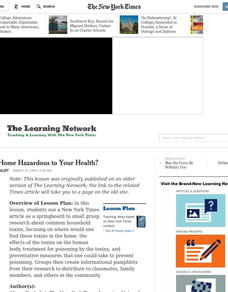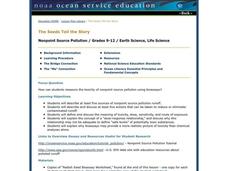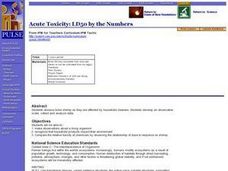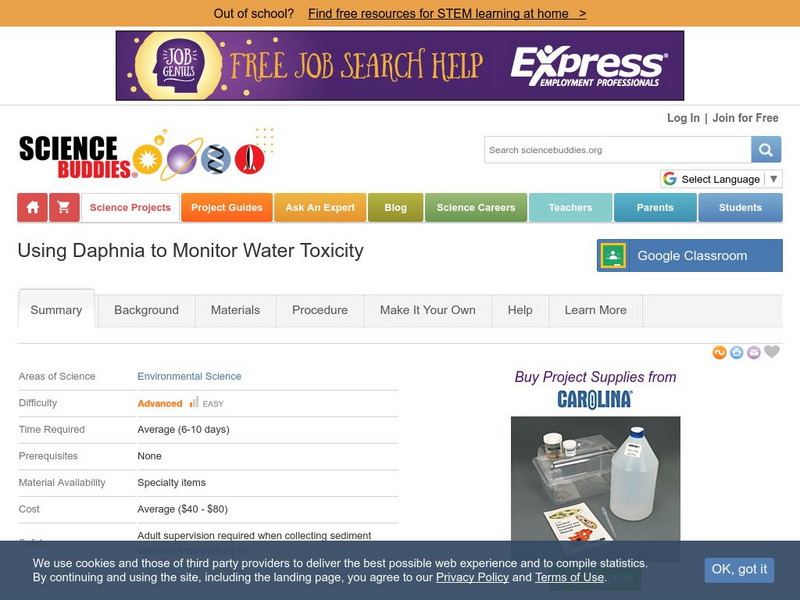Curated OER
Health Education: Toxins
Student hear about harmful household products. For this personal health lesson plan, 3rd graders summarize why household products are harmful if ingested or inhaled.
Curated OER
Kids and Chemicals - Facts and Laws
Students examine the impact of everyday toxins on the health of people. They conduct a cost-benefit analysis, watch a video, conduct Internet research, complete a Synthetic Chemical Exposure Chart, and write a one-page summary.
Curated OER
Is Your Home Hazardous to Your Health?
Students use a newspaper article as a springboard to small group research about common household toxins, focusing on where would one find these toxins in the home, the effects of the toxins on the human body and treatment for poisoning...
Curated OER
The Seeds Tell the Story
Students explore sources of pollution runoff and actions that can be taken to reduce runoff. In this pollution lesson students complete a worksheet and see why bio-essays may provide a more realistic picture of toxicity.
Curated OER
Hazard Symbols
In this hazard symbols worksheet, students are given 6 symbols commonly used in the lab for hazardous materials, agents and situations. Students look for each symbol around the classroom, on worksheets and in textbooks.
Curated OER
Hazardous Products Substitutes
Students investigate toxic substances. In this health lesson, students identify warning labels on common household cleaners and create a "less toxic" cleaning recipe book. Students recite a pledge to try a less toxic substitute at home.
Curated OER
N, B, and T: Pollutants Three
Students explore nutrient, bacterial, and toxic surface water pollution. They identify the amount of water they use each day and summarize the kinds of substances that cause water pollution. They predict what will happen in water...
Curated OER
Toxic Torts
Twelfth graders examine the role of courts in environmental law enforcement. Using examples, they identify civil cases brought against large corporations for violating environmental laws. They define new vocabulary and discuss the...
Curated OER
Fertilizers, Pesticides and Health
Students apply real data to create and calculate algebraic equations. Students create a visual to represent the concentration for one part per million and apply unit analysis to verify measurement computations. Students define the use...
Curated OER
Lead Usage Through History
Learners read 2 assigned articles about lead usage with a partner or team. They create a concept map or timeline using Inspiration software to trace the uses of lead by people. They complete a brief constructed response and are graded...
Curated OER
Toxicology and Living Systems
Learners investigate how toxic chemicals affect biological systems. They determine the toxic dose of a chemical that inhibits seed germination in a Brassica rapa. They investigate the effect of environmental tobacco smoke on human lung...
Curated OER
Operation Mexfly
Students research information about pesticides. Students discuss the history of the Mexican fruit fly. They experiment to discover malathion concentration levels in organisms. Students explore the effect of toxins at the top of the...
Curated OER
What's Hiding in Your Home Cabinets?
Students analyze a variety of products found in their own homes to determine their toxic content. They identify words such as caution, warning or danger and relate them to their relative toxicity levels.
Curated OER
Hazardous Waste Hot Potato
Students investigate hazardous substances. They work in groups to decide how to properly dispose of such materials..
Curated OER
Using Hazard Symbols
In this hazards worksheet, students determine what the different hazard symbols mean and then match the symbols that would be found on specific chemicals. This worksheet has 1 matching and 3 short answer questions.
Curated OER
Construction Safety
In this construction safety worksheet, students identify and locate vocabulary words in a word search related to construction safety. There are 54 words in the puzzle.
Curated OER
Disposal of Old Paint
Students identify toxic household products that should not be disposed of in a landfill. They select alternative disposal procedures involving toxic products. Students write a news program for a local TV station discussing and...
Curated OER
Is It Safe To Go In?
Students examine acceptable levels of toxins in swimming areas. Working in groups of four, students dilute a salt or sugar solution to 1 part per 1,000,000 (ppm) solution. Students taste test their diluted liquids and record at which...
Curated OER
Acute Toxicity: LD50 by the Numbers
Students observe brine shrimp as they are affected by household cleaners, develop observation scale, collect and analyze data, and discuss how household products and pesticides negatively impact environment.
Curated OER
Science: Testing Water for Toxicity
Students investigate the potential toxicity of water samples using California blackworms to test water quality. They observe the worms' behaviors in different water samples and determine which sample has the highest toxicity. At the...
Science Buddies
Science Buddies: Weeds Be Gone! Experiment That Affect Roundup Weed Killer
Experiment with factors that affect the activity of the weed killer Roundup. The Science Buddies project ideas are set up consistently beginning with an abstract, objective, and introduction, followed by a section on terms, concepts, and...
Science Buddies
Science Buddies: Using Daphnia to Monitor Water Toxicity
In a bioassay, a living organism serves as a detector for toxins-the same way canaries were used in coal mines to detect invisible toxic gases. In this project, water fleas (Daphnia magna), a freshwater crustacean, are used in a bioassay...
Other
Univ Calif Riverside: Medically Important Arachnids
A web site devoted to describing the numerous venomous arachnids that have a medical importance to humans, as well as a description of how these arachnids aid humans.
Massachusetts Institute of Technology
Mit: Open Course Ware: Chemicals in the Environment: Toxicology and Public Health
A college course featuring instructor's notes and case studies about the relationship between exposure to environmental chemicals and human diseases.

























